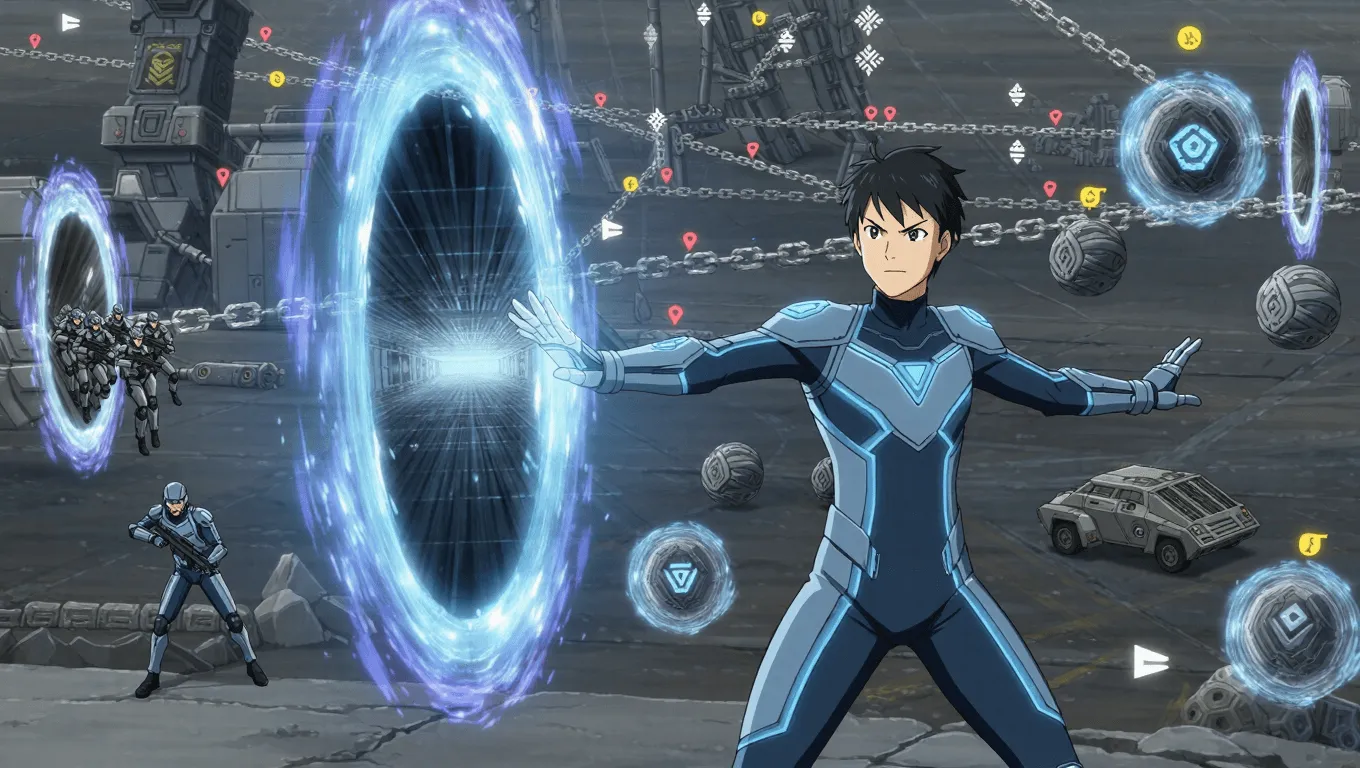Dimensional Travel

Dimensional Travel Video Demo 🎬
Table of Contents
- Dimensional Travel Video Demo 🎬
- What Is Dimensional Travel
- Core abilities of Dimensional Travel
- Application / Tactical Advantages in Combat
- Level: Level 1 🏙️, Level 2 🌇, Level 3 🌃
- Limitations of using the Dimensional Travel
- Weakness against what other superpowers
- Synergistic Power Combos
- Known Users
Dimensional travel is the superpower to cross boundaries between universes, timelines, and layered planes of reality. As a catch-all for interdimensional travel, multiverse traversal, portal creation, and pocket dimension access, it provides unmatched mobility and strategic control. In stories and games alike, this ability lets a character bypass distance, evade traps, and reshape battlefields by stepping across the seams of reality. For a broader catalog of abilities, check the superpower wiki or try a new idea with the random superpower generator.
What Is Dimensional Travel
Dimensional travel is the capability to move a person, object, or team from one reality to another by opening, navigating, and stabilizing gateways between them. “Reality” here can mean parallel Earths, astral planes, mirrored timelines, hellscapes, dreamscapes, or engineered simulation layers. Some users tear rifts with raw power; others use rituals, sigils, or advanced portal technology. A few do not open passageways at all—instead, they phase their bodies out of one dimension and into another by altering their dimensional frequency.
Because dimensions often obey different physical laws, this power doubles as a toolkit for problem-solving. One dimension may offer low gravity for high jumps; another might slow time; a third could mute sound for stealth. Skilled travelers treat the multiverse as a tactical map.
Core abilities of Dimensional Travel
Portal creation
The user generates a doorway, ring, or tear in space that links two points—across a room, across a planet, or across universes. Mature portal creation includes edge stabilization (to prevent shredding winds), frame locking (to keep the exit where intended), and aperture shaping (from coin-sized holes to city-scale arches).
Dimensional phasing
Rather than opening a visible gate, the traveler “slides” between layers, becoming intangible to local matter and reappearing in a neighboring plane. Phasing allows silent infiltration, wall-passing, and brief invulnerability while between layers.
Coordinate sensing and anchoring
Reliable dimensional navigation requires “addresses.” Users imprint anchors—beacons, runes, or quantum tags—so they can return precisely. Without anchors, coordinates drift, increasing the risk of landing in a void pocket or hazardous realm.
Pocket dimension access and storage
Travelers often maintain private micro-universes for armories, medbays, or hideouts. These pockets suspend time, adjust gravity, or offer friendly atmospheres. Advanced users can expand or compress pocket space on demand.
Dimensional perception
The user senses seams in reality: weak points, natural wormholes, and cosmic ley lines. This perception prevents accidental breaches, detects hostile portals, and flags timeline instabilities before they ripple outward.
Temporal side-effects
While not equivalent to full time travel, dimensional hops can brush adjacent timelines, enabling short rewinds, alternate-branch scouting, or “echo” visits that leave no footprint. This is fragile and often carries paradox safeguards.
Application / Tactical Advantages in Combat
-
Positioning supremacy: Step behind enemy lines, flank fortified positions, or bypass kill zones. A squad can deploy from a safe pocket straight into high ground.
-
Hit-and-fade warfare: Open a portal, fire through from cover, and close it before retaliation. With multiple exits, attacks seem to come from everywhere at once.
-
Extraction and rescue: Evacuate wounded allies in seconds to a prepared med-pocket; insert reinforcements without exposing transports to fire.
-
Battlefield denial: Redirect projectiles or stampedes into harmless dead-zones. A narrow rift across a corridor becomes a no-pass barrier.
-
Environmental leverage: Lure opponents into low-oxygen, high-pressure, or anti-magic dimensions that suppress their strengths.
-
Logistics at scale: Move supplies, vehicles, or entire battalions with minimal footprint. Strategic campaigns become multi-front operations run from a secure extradimensional hub.
-
Intelligence gathering: Scout alternate timelines to observe enemy choices without committing to a fight, then return with optimized plans.
Level: Level 1 🏙️, Level 2 🌇, Level 3 🌃
Level 1 🏙️ — Local rifts and phase slips

Beginners open short-range portals (line-of-sight to a few city blocks) or briefly phase through walls. Travel is tiring and imprecise; exits can drift by meters. Best uses: infiltration, escape, small-unit flanking, and quick supply drops. Anchors are simple—chalk sigils, beacon pucks, or instinctive “home feel.”
Level 2 🌇 — Stable gateways and pocket management

Intermediate users maintain room-to-stadium-sized portals for minutes, chain multiple exits, and manage pocket dimensions for storage or staging. They can escort teams, vehicles, and heavy equipment with reasonable safety. Navigation becomes map-driven: coordinates are cataloged, tested, and tagged with risk levels. Combat role expands to battlefield architect—controlling tempo, terrain, and routes.
Level 3 🌃 — Multiversal traversal and timeline threading

Masters traverse distant planes, hostile cosmologies, and branching timelines with high precision. They field mobile safehouses, lay covert anchors inside fortified realms, and route entire operations through extradimensional corridors. Side-effects like “time echoes” or alternate-branch reconnaissance become tools, not accidents. Their presence can rewrite theaters of war: blockades vanish, borders blur, and encirclements collapse overnight.
Limitations of using the Dimensional Travel
-
Energy and strain: Large or long-duration portals burn stamina, fuel, or rare catalysts. Overextension causes nausea, vertigo, or catastrophic rift collapse.
-
Precision risk: Without calibrated anchors, exits wander. A few degrees off can land a traveler in vacuum, caustic atmospheres, or light-delay traps.
-
Local physics mismatch: Different constants mean different dangers—crushing pressure, frozen time, or hostile sentience embedded in the environment.
-
Causality safeguards: Many universes enforce paradox control. Attempts to alter fixed points trigger recoil—portals jam, users get bounced, or reality “heals” the change elsewhere.
-
Wards and interdiction: Anti-portal sigils, dimensional cages, quantum locks, and cosmic treaties can block or prosecute unauthorized crossings.
-
Traceable signatures: Frequent travelers leave spectral fingerprints. Dimensional trackers, seers, or gate-watch AIs can follow these across jumps.
-
Team coordination: Moving groups safely requires spacing, timing, and trust. Panic, crowding, or mid-step interference can shear formations or strand stragglers.
Weakness against what other superpowers
-
Reality anchoring / field stabilization: Powers or devices that pin local reality shut rifts, forcing the traveler to fight on conventional terms.
-
Anti-magic or dampening fields: By reducing the output needed for gate integrity, these fields cause premature portal collapse or total failure.
-
Temporal immunity and fixed-point guardians: Targets protected from timeline edits nullify reconnaissance through branch hopping.
-
Spatial distortion counters: Gravity wells, space folding, or localized singularities can bend or snap a portal edge, shredding it into harmless sparks.
-
Severing and banishment: Exorcists, cosmic adjudicators, or “banisher” tech forcibly eject interlopers from protected dimensions.
-
Speed blitz and interference: Ultra-fast opponents can cross and disrupt a gateway before it stabilizes, or shove the traveler mid-cast to misalign the exit.
Synergistic Power Combos
-
Spatial manipulation: Pairing with space folding or wormhole shaping yields hyper-efficient, low-loss gateways and curved-trajectory shots through linked portals.
-
Time manipulation: Momentary slows or pauses grant safe setup for complex gate geometry, plus clean extractions from collapsing timelines.
-
Clairvoyance / cosmic senses: Remote viewing and probability sight reduce hazardous exits, help sniff out traps, and identify unwarded routes.
-
Force fields and hard-light: Edge-lining a portal with hard-light frames protects travelers from crosswinds, shrapnel, and hostile atmospheres.
-
Energy projection: Fire-and-fade tactics become brutal when beams, bolts, or sonic cones can emerge from any angle, then vanish.
-
Technomancy / portal tech: Calibrators, anchor relays, and dimensional charts cut energy costs and standardize safe routes for teams and cargo.
-
Illusion and misdirection: Fake gateways bait enemies; real exits appear elsewhere. Combined with decoys, this multiplies confusion on the field.
Known Users
Dimensional travel features across comics, games, and mythology. Notable characters include Doctor Strange, a sorcerer who frequently opens portals to the Mirror Dimension and beyond, America Chavez, who punches star-shaped portals across the multiverse, and The Authority’s door-builders who step between realities as easily as rooms. For more on one famous practitioner, see Doctor Strange. To continue exploring related abilities, browse the superpower wiki or spin up a new idea with random superpower generator.
